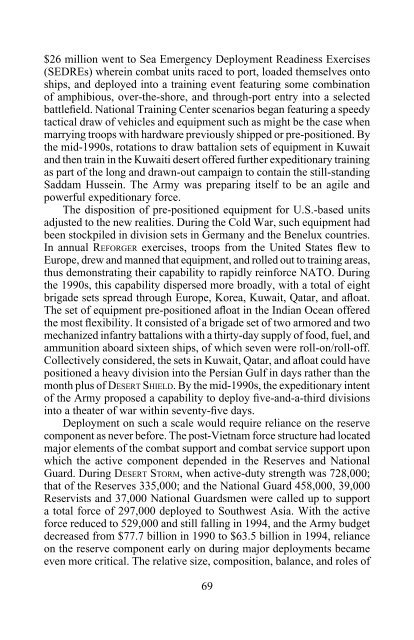You also want an ePaper? Increase the reach of your titles
YUMPU automatically turns print PDFs into web optimized ePapers that Google loves.
$26 million went to Sea Emergency Deployment Readiness Exercises(SEDREs) wherein combat units raced to port, loaded themselves ontoships, and deployed into a training event featuring some combinationof amphibious, over-the-shore, and through-port entry into a selectedbattlefield. National Training Center scenarios began featuring a speedytactical draw of vehicles and equipment such as might be the case whenmarrying troops with hardware previously shipped or pre-positioned. Bythe mid-1990s, rotations to draw battalion sets of equipment in Kuwaitand then train in the Kuwaiti desert offered further expeditionary trainingas part of the long and drawn-out campaign to contain the still-standingSaddam Hussein. The Army was preparing itself to be an agile andpowerful expeditionary force.The disposition of pre-positioned equipment for U.S.-based unitsadjusted to the new realities. During the Cold War, such equipment hadbeen stockpiled in division sets in Germany and the Benelux countries.In annual Reforger exercises, troops from the United States flew toEurope, drew and manned that equipment, and rolled out to training areas,thus demonstrating their capability to rapidly reinforce NATO. Duringthe 1990s, this capability dispersed more broadly, with a total of eightbrigade sets spread through Europe, Korea, Kuwait, Qatar, and afloat.The set of equipment pre-positioned afloat in the Indian Ocean offeredthe most flexibility. It consisted of a brigade set of two armored and twomechanized infantry battalions with a thirty-day supply of food, fuel, andammunition aboard sixteen ships, of which seven were roll-on/roll-off.Collectively considered, the sets in Kuwait, Qatar, and afloat could havepositioned a heavy division into the Persian Gulf in days rather than themonth plus of Desert Shield. By the mid-1990s, the expeditionary intentof the Army proposed a capability to deploy five-and-a-third divisionsinto a theater of war within seventy-five days.Deployment on such a scale would require reliance on the reservecomponent as never before. The post-Vietnam force structure had locatedmajor elements of the combat support and combat service support uponwhich the active component depended in the Reserves and NationalGuard. During Desert Storm, when active-duty strength was 728,000;that of the Reserves 335,000; and the National Guard 458,000, 39,000Reservists and 37,000 National Guardsmen were called up to supporta total force of 297,000 deployed to Southwest Asia. With the activeforce reduced to 529,000 and still falling in 1994, and the Army budgetdecreased from $77.7 billion in 1990 to $63.5 billion in 1994, relianceon the reserve component early on during major deployments becameeven more critical. The relative size, composition, balance, and roles of69












